CO837 Natural Computation
advertisement
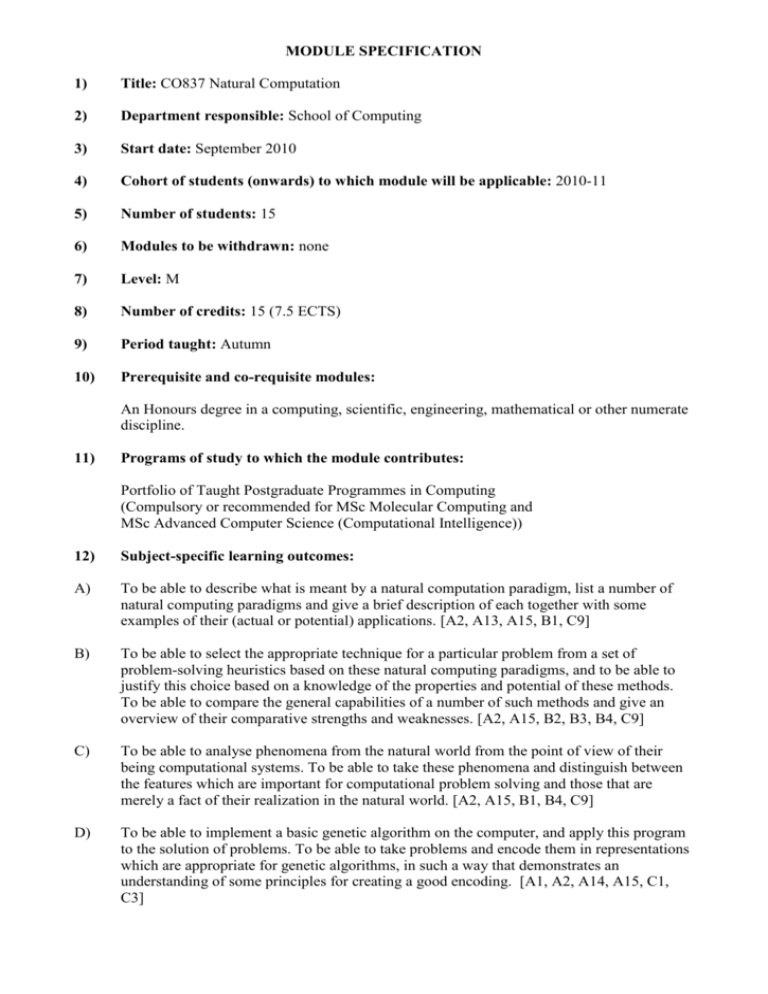
MODULE SPECIFICATION 1) Title: CO837 Natural Computation 2) Department responsible: School of Computing 3) Start date: September 2010 4) Cohort of students (onwards) to which module will be applicable: 2010-11 5) Number of students: 15 6) Modules to be withdrawn: none 7) Level: M 8) Number of credits: 15 (7.5 ECTS) 9) Period taught: Autumn 10) Prerequisite and co-requisite modules: An Honours degree in a computing, scientific, engineering, mathematical or other numerate discipline. 11) Programs of study to which the module contributes: Portfolio of Taught Postgraduate Programmes in Computing (Compulsory or recommended for MSc Molecular Computing and MSc Advanced Computer Science (Computational Intelligence)) 12) Subject-specific learning outcomes: A) To be able to describe what is meant by a natural computation paradigm, list a number of natural computing paradigms and give a brief description of each together with some examples of their (actual or potential) applications. [A2, A13, A15, B1, C9] B) To be able to select the appropriate technique for a particular problem from a set of problem-solving heuristics based on these natural computing paradigms, and to be able to justify this choice based on a knowledge of the properties and potential of these methods. To be able to compare the general capabilities of a number of such methods and give an overview of their comparative strengths and weaknesses. [A2, A15, B2, B3, B4, C9] C) To be able to analyse phenomena from the natural world from the point of view of their being computational systems. To be able to take these phenomena and distinguish between the features which are important for computational problem solving and those that are merely a fact of their realization in the natural world. [A2, A15, B1, B4, C9] D) To be able to implement a basic genetic algorithm on the computer, and apply this program to the solution of problems. To be able to take problems and encode them in representations which are appropriate for genetic algorithms, in such a way that demonstrates an understanding of some principles for creating a good encoding. [A1, A2, A14, A15, C1, C3] E) To be able to describe some examples of how physical devices other than traditional electronics can be used to form the basis of computing systems, and to be able to discuss in an informed way reasons why these devices might be better than traditional devices for some applications. To be able to apply similar reasoning to the analysis of related systems not directly studied on the course. [A2, A3, A14, A15, B1, B4, C9] 13) Generic learning outcomes: F) To be able to exploit library and online resources to support investigations into these areas. [D2] To be able to write coherently and critically about the topics studied in the course, based on readings from the scientific literature and demonstrating an awareness of how to write in a scientific manner. [D6, D7] To be able to apply mathematical techniques where appropriate. To be able to apply appropriate computer programming techniques. [A1] To be able to apply appropriate scientific principles and methodology. [B3] To be able to study independently and apply principles and techniques used in the course to new examples. [D1, D3] To be able to work with self-direction and originality in tackling and solving problems. [B5] To be able to make sound judgements in the absence of complete data. [B6] Ability to review a research paper or technical report critically and to present findings to a group of peers. [B7] G) H) I) J) K) L) M) N) 14) Synopsis of the curriculum: Motivation. There is an increasing use of nature-inspired computational techniques in computer science. These include the use of biology as a source of inspiration for solving computational problems, the application of artificial intelligence techniques to various problems, and the use of physical, chemical and biological and systems to construct computers. It is therefore proposed to allow students the opportunity to become exposed to these ideas for use in their late careers. Syllabus Introductory material. Is computer science the study of computers as products of human ingenuity or the study of natural processes? Is computing actually a property of the natural world? Is it possible to interpret natural phenomena using computational concepts? The use of metaphor, model and inspiration in computer science. Issues concerning scientific method and methodology. What sort of scientific questions can we answer using computational and informational concepts? Examples of biological problems that can be tackled using computational concepts (not computer simulation of biosystems). Using computational properties of the world directly for problem solving. Evolutionary computing. General context via the idea of biologically-inspired computing techniques. Genetic algorithms: basic ideas, details of selection, crossover, mutation algorithms, how to choose between various types of algorithms. Genetic programming. Artificial immune systems. Background to the biological immune system, how these ideas are abstracted to create AISs. Framework for AIS design. Applications. Swarm intelligence. Basic ideas. Ant colony optimization. Particle swarm optimization. Applications. Computation based on chemistry. Exploiting properties of chemicals to do computing. DNA computing and applications. Wavefront computing and applications. Artificial life and simulated biology. The distinction between using computers to study existing biological systems and using them to investigate what life in general could be like. Reasons for using computers in biology. Applications of artificial life and biological simulation in a number of biological and medical areas; e.g. ecology, evolution, molecular biology, and/or cancer research. Theoretical notions such as emergence and the complex systems stance towards the natural world. 15) Indicative Reading List: 16) P. Bentley, Digital Biology, Hodder-Headline, 2001. (for introductory overview) L.N. DeCastro and J. Timmis, Artificial Immune Systems, Springer, 2002. L.N. DeCastro and F. von Zuben, Recent Developments in Biologically Inspired Computing, Idea Group, 2004. M. Mitchell, An Introduction to Genetic Algorithms, 1998. M. Dorigo and T. Stutzle, Ant Colony Optimization, MIT Press, 2004. Learning & Teaching methods: This module represents a total of 150 hours of study, broken down approximately as follows: 17) 22 lectures 5 seminars The remainder for private study including assessment. Assessment methods: Students are graded on a percentage scale with 40% as the pass mark. The module will be assessed by two pieces of coursework (40%) which test learning outcomes A-N and an examination (60%) which tests learning outcomes A-C, E, G, H and J-M. 18) Implications for learning resources, including staff, library, IT and space: Teaching will be undertaken by existing academic staff from the School of Computing using timetabled university lecture/seminar rooms and existing teaching space within the School. Students will require normal access to university library and IT resources. A small number of core texts may need to be purchased. 19) A statement confirming that, as far as can be reasonably anticipated, the curriculum, learning and teaching methods and forms of assessment do not present any nonjustifiable disadvantage to students with disabilities. The School of Computing recognises and has embedded the expectations of SENDA, and supports students with a declared disability or special (educational) need in its teaching, through the establishment of Inclusive Learning Plans agreed between student, department and the Disability Support Unit. We will liaise with the Disability Support Unit in order to provide specialist support where needed. Statement by the Director of Learning and Teaching: "I confirm I have been consulted on the above module proposal and have given advice on the correct procedures and required content of module proposals" ................................................................ .............................................. Director of Learning and Teaching Date Statement by the Head of Department: "I confirm that the Department has approved the introduction of the module and will be responsible for its resourcing" ................................................................. Head of Department Last updated – 22 March 2010 .............................................. Date
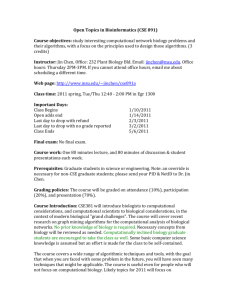


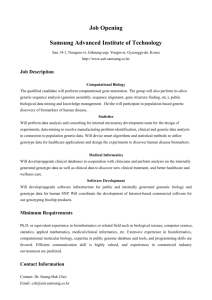

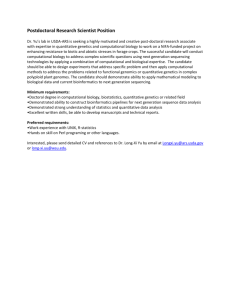


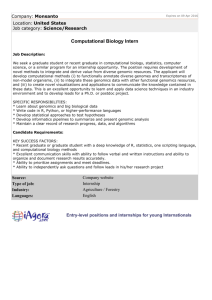
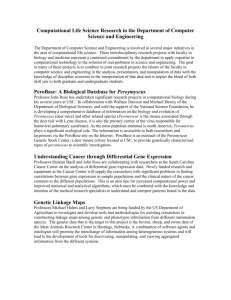
![Measurement of the Mass Difference between t and t[over- bar] Quarks](http://s2.studylib.net/store/data/012101994_1-37241c71f6aef27ef4a9f02b9126a637-300x300.png)